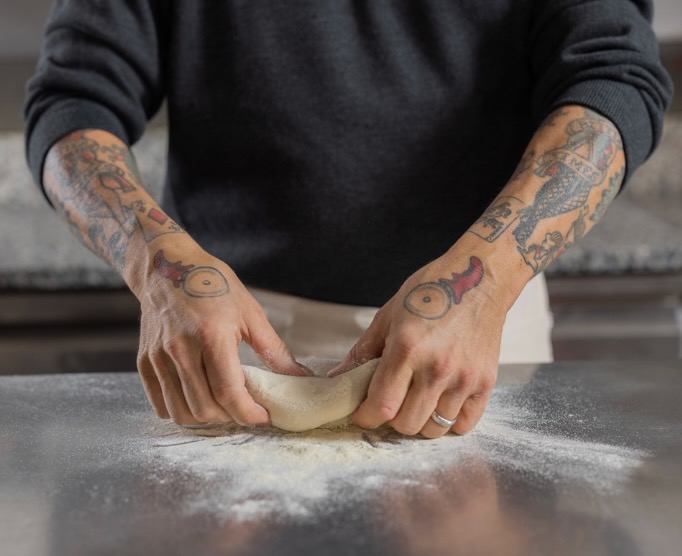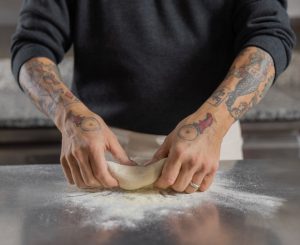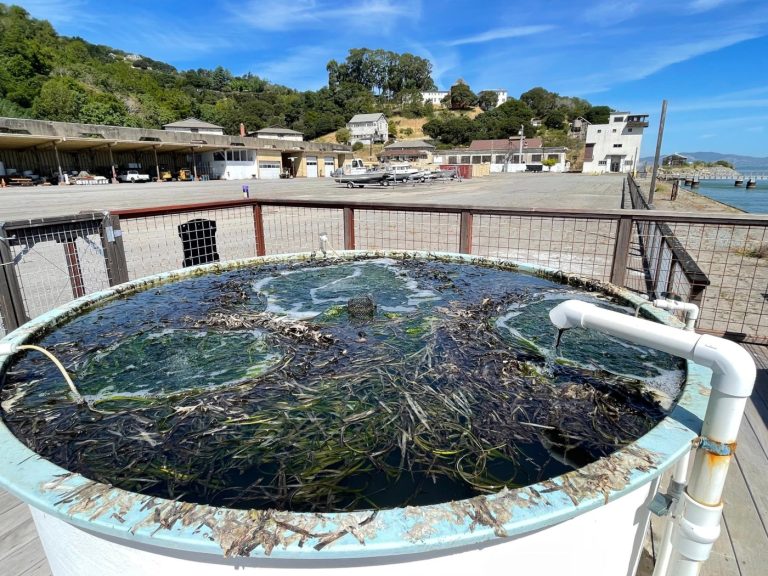It’s the start of summer, which means it’s a great time to host your own pizza party. (And really, is there ever a bad time for a DIY pizza party?)
To help, three new pizza-centric cookbooks have recently debuted, each dedicated to helping you step up your home pizza game. The quest to bake the perfect pie might just become your next hobby — the opportunities for specialty gear are myriad — but in the meantime, here are a few tips from the cookbooks and their authors.
The Pursuit of Pizza: Recipes from the World Pizza Champions by Tony Gemignani, Laura Meyer, Nick Bogacz and Mike Bausch
“The Pursuit of Pizza: Recipes from the World Pizza Champions,” by Tony Gemignani, Laura Meyer, Nick Bogacz and Mike Bausch was published in March. (Courtesy Windermere Press)
Tony Gemignani is perhaps the Bay Area’s most prominent pizzaiolo, as the chef and restaurateur behind Tony’s Pizza Napoletana, Tony’s Coal Fired Pizza, Capo’s and more. Now his empire of Slice House locations — in Walnut Creek and beyond — is expanding across the country, with more than 40 pizzerias now in operation and 150 locations under development, he says.
A Slice House opened in Mountain View last week, and additional locations are planned in San Jose, Fremont, Dublin and Livermore.
Gemignani, author of “The Pizza Bible,” grew up in Fremont and began working at his brother’s Castro Valley pizzeria before becoming a pizza-throwing competitor on the international stage. He now lives in Alamo with his family.
“Pursuit of Pizza” was written by pizza pros for pizza enthusiasts, he says. In addition to recipes, the cookbook includes QR codes that link readers to video tutorials by the authors, who include Laura Meyer from Berkeley’s Pizzeria da Laura.
“The key to great pizza is the ingredients,” the four-time cookbook author says. And when it comes to sourcing ingredients, thanks to the global accessibility of ingredients here and online, Gemignani can be more precise in his recipes than he used to be, offering specific suggestions for the types of tomatoes, flour and olive oil to use.
Whether you’re talking about his signature base dough or his basil and burrata-topped Cortopasso pizza, “in every case, better ingredients yield better results,” he says in the new book, which embraces ever pizza style, from calzones to New York and Detroit style. “I celebrate every pizza I know how to make.”
Tony Gemignani is a 13-time world pizza champion and co-author of a new cookbook, “The Pursuit of Pizza.” (Courtesy Marc Fiorito, Gamma Nine)
Details: “The Pursuit of Pizza: Recipes from the World Pizza Champions,” by Tony Gemignani, Laura Meyer, Nick Bogacz and Mike Bausch (From $1.99 e-edition, Windermere Press); a portion of book royalties goes to the Make-A-Wish Foundation.
Pizza Night: Deliciously Doable Recipes for Pizza and Salad by Alexandra Stafford
Food blogger and cookbook author Alexandra Stafford’s personal connection to the tradition of Friday family pizza night dates back to childhood. She’s kept up the tradition in her own family, and during the pandemic, began experimenting with different ways to add variety to her family’s pizza nights.
After her first cookbook, “Bread Toast Crumbs,” she’d developed a reputation as a go-to for items like bread and pizza. So Stafford decided to build out an entire cookbook with a different pizza and salad combination for 52 pizza nights, a year of those Friday evening charmers.
Stafford began her career in Philadelphia, working in professional kitchens and as a food writer. It was 2006, and blogs were starting to take off, so she launched one of her own — just for fun, at first. Then AlexandraCooks took off.
So what does a great pizza need? Ingredients measured carefully by weight using a digital scale, a pizza steel to balance your oven’s heat, and a bit of patience are three simple ways to boost your pizza game, she says. Her Neapolitanish pizza dough takes two to three days of fridge time to reach perfection, before you embellish it with toppings for, say, Peach Pizza with Prosciutto.
“Pizza Night: Deliciously Doable Recipes for Pizza and Salad” by Alexandra Stafford (Clarkson Potter, $30) was published April 16. (Courtesy Clarkson Potter)
Using a digital scale is “the single most important step you can take to make homemade pizza a simpler and more foolproof process,” she writes. It allows more precision, and it can help you troubleshoot to get more precise ratios between water and flour.
A pizza steel is like a baking or pizza stone, but conducts heat even better, helping the dough to crisp up and turn bubbly. “Compared to investing in an outdoor pizza oven, a baking steel is the best investment you can make in making better pizza at home,” she says.
Details: “Pizza Night: Deliciously Doable Recipes for Pizza and Salad” by Alexandra Stafford (Clarkson Potter, $30) was published April 16.
Pizza Volume 01: A guide to your pizza-making journey and other outdoor recipes by Gozney
A guide to your pizza-making journey and other outdoor recipes” by Gozney was published May 14. (Courtesy HarperCollins)
Outdoor pizza ovens, like those made by Gozney, have become incredibly popular on the backyard kitchen scene. So in May, founder Tom Gozney published a cookbook of his own, “Pizza Volume 01: A guide to your pizza-making journey and other outdoor recipes.”
Of course, getting a Gozney pizza oven is not a light commitment; these pizza domes retail near $2,000 and weigh 150 pounds. (They also offer a portable pizza oven design — Roccbox — that retails for closer to $500.)
This beautifully-designed cookbook offers more than 75 recipes for pizza and 20 for other types of outdoor cooking, collected from a roster of chefs.
While the success of a pizza crust comes down to just four simple ingredients — flour, yeast, salt and water — precision makes a difference. Different flours, he explains, contain different levels of protein content, which shapes how much gluten develops, which affects crispiness, hole structure and chewiness. The more gluten, the chewier the crust. Generally, pizza flours range from 9% to 15% protein content; a higher-protein flour will yield a stronger and firmer dough and can absorb more water.
Related Articles
Summer treats: Make this Strawberry Cardamom Frozen Yogurt with Balsamic Swirl
TasteFood: Move the meal outdoors with this easy Greek dinner
Fresh bread is great, but day-old bread can be even better
Quick Fix: Steak Fajita Pizza
Make any night date night with this riff on steak frites
If that sounds too much like science — well, it is. But here’s another, simpler way to add complexity to your homemade pizza. Shake up your toppings — not just the meats, cheeses and veggies but the herbs and garnishes, Gozney writes. Basil and oregano are classics, but why not try rosemary, thyme or parsley?
Details: “Pizza Volume 01: A guide to your pizza-making journey and other outdoor recipes” by Gozney (HarperCollins, $34.99)












